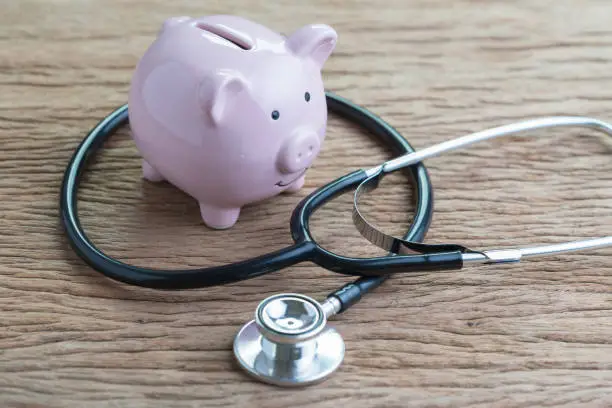We envision a world where everyone has the tools and knowledge to live a balanced, healthy, and fulfilling life. By providing reliable resources, personalized programs, and community support, we aim to be a beacon of hope for those on their health journey.
Table of Contents
Introduction: The Connection Between Health and Finances
Richer and Healthier1
The relationship between maintaining healthy habits and financial savings is often understated yet profoundly significant. When individuals prioritize their well-being through regular exercise, a balanced diet, and adequate rest, they can experience an array of positive outcomes that greatly impact their financial situation. One of the most apparent benefits of adopting a healthier lifestyle is the reduction in medical expenses. Chronic illnesses, which frequently arise from poor lifestyle choices, can lead to considerable healthcare costs over time. By focusing on preventive health measures, individuals can mitigate the risk of developing such conditions, thereby fostering significant savings on medical bills.
Additionally, maintaining good health can lead to a decreased reliance on medications. While prescription drugs can be vital for managing specific health issues, long-term use can be financially burdensome. By engaging in healthy behaviors, such as exercising regularly and consuming a nutritious diet, individuals can often reduce the necessity for these medications, resulting in further financial relief. This is not only advantageous for personal finances but also lessens the strain on public healthcare systems.
Moreover, good health is intrinsically linked to increased productivity. Healthy individuals often show higher levels of energy and motivation, which can enhance their performance at work or in daily activities. This heightened productivity may lead to better job performance, potential promotions, and increased earning capacity. Consequently, the benefits of healthy habits extend beyond mere physical well-being; they also encompass substantial financial advantages that accrue over time. Thus, as we delve deeper into this topic, it becomes clear that the imperative to embrace healthy habits is not solely a matter of personal health, but also a pivotal strategy for achieving long-term financial stability.
Understanding Healthy Habits: What Are They?

Healthy habits refer to practices and lifestyle choices that promote overall well-being and contribute to longevity. Key components of these habits include regular exercise, balanced nutrition, adequate sleep, and effective stress management. By incorporating such practices into daily routines, individuals can significantly enhance their physical and mental health, ultimately influencing their financial standing.
Regular exercise involves engaging in physical activities that improve cardiovascular fitness, strength, and flexibility. Good Health More Wealth learn How Staying Healthy Saves You Money; This not only helps in maintaining a healthy weight but also reduces the risk of chronic diseases such as heart disease and diabetes, which can incur costly medical expenses over time. Incorporating a mix of aerobic, strength training, and flexibility exercises can provide comprehensive health benefits, leading to long-term savings on healthcare costs.
Balanced nutrition plays a crucial role in supporting health. A diet rich in fruits, vegetables, whole grains, and lean proteins provides essential nutrients that fortify the body against illness. Conversely, poor dietary choices can lead to obesity and related health complications, increasing healthcare expenditure. Therefore, understanding the principles of nutrition fosters better eating habits, which can lead to improved health outcomes and more effective management of medical expenses.
Adequate sleep is another essential component of healthy habits. Quality sleep aids in physical recovery, cognitive function, and emotional well-being. Insufficient sleep has been linked to various health issues, which in turn can lead to increased costs due to medical treatments. Prioritizing restorative sleep can mitigate these risks and lower healthcare costs.
Lastly, stress management techniques, such as mindfulness and regular relaxation practices, contribute to mental health. Chronic stress can lead to numerous health problems, many of which incur high costs. By addressing stress proactively, individuals can enhance their quality of life while saving money in the process. Implementing these healthy habits collectively establishes a solid foundation for reducing future health-related expenses and supports a lifestyle focused on both well-being and financial prudence.
Reduced Healthcare Costs: A Financial Benefit
Adopting healthy habits significantly contributes to a decrease in healthcare costs, impacting individuals and families alike. Numerous studies indicate that individuals who engage in regular physical activity, maintain a balanced diet, and avoid harmful behaviors such as smoking are less likely to experience chronic health issues. For instance, according to the Centers for Disease Control and Prevention (CDC), chronic diseases such as heart disease, diabetes, and obesity are among the leading causes of reduced quality of life and increased healthcare expenditures in the United States. By making relatively small adjustments to diet and lifestyle, individuals can reduce the incidence of these diseases and, consequently, the financial burdens associated with them.
Research highlights that maintaining a heal-thy weight through proper nutrition and exercise can decrease heal-thcare costs. The American Journal of Public Hea-lth published findings suggesting that physical inactivity alone costs the U.S. hea-lthcare system approximately $117 billion annually. Each hospital visit, required treatment, or prescription for medication can add up substantially over time. By prioritizing hea-lth through preventative measures, such as regular exercise and a nutritious diet, one can drastically reduce the need for these interventions.
In addition, the financial implications of mental hea-lth play a crucial role in hea-lthcare costs. Engaging in stress-reduction techniques such as mindfulness, yoga, or regular physical activities can lead to improved mental well-being. The World Hea-lth Organization (WHO) reports that mental hea-lth disorders cost the global economy an estimated $1 trillion each year in lost productivity. A healthier lifestyle doesn’t only enhance physical hea-lth; it can also lead to fewer missed workdays and increased productivity, further compounding financial savings.
Overall, the integration of heal-thy habits into daily routines results in noticeable reductions in hea-lthcare needs and costs. These savings prove to be a financial benefit, emphasizing the profound relationship between hea-lth and economic well-being.
Grocery Savings: Eating Healthy on a Budget

Eating heal-thy does not have to be synonymous with high expenses. In fact, adopting a strategy focused on cooking at home and selecting nutrient-rich foods can often lead to significant savings. Fast food and processed options may seem convenient; however, they frequently incur higher costs in the long run, not just financially but also in terms of hea-lth. By preparing meals at home, individuals have the advantage of controlling ingredients, portion sizes, and ultimately, costs.
One effective method for reducing grocery expenses while maintaining a heal-thy diet is meal planning. By organizing meals for the week, individuals can create a focused shopping list, which minimizes impulse purchases and reduces food waste. This focused approach allows one to buy foods in bulk, often leading to lower prices per unit. Incorporating seasonal produce into meal plans not only offers freshness but also tends to be more affordable.
Another strategy to consider is shopping at local farmers’ markets or opting for generic brands, which frequently provide the same quality as name-brand items at a fraction of the price. Preparing meals in larger quantities and freezing leftovers can also extend the value of groceries, ensuring that heal-thy meals are readily available throughout the week without succumbing to temptations for less nutritious takeout.
Utilizing coupons and taking advantage of sales can further amplify savings while grocery shopping. Focusing on budget-friendly staples such as legumes, grains, and in-season vegetables can boost nutrition without breaking the bank. Regular engagement with heal-thy cooking can not only improve well-being but also contribute to an overall reduction in long-term food expenses. Adopting these budget-friendly strategies can be an essential step toward a healthier lifestyle while keeping financial goals in check.
The Productivity Link: Earn More by Being Healthy
Good hea-lth is a vital yet often underestimated factor contributing to increased productivity in both personal and professional spheres. Individuals who prioritize heal-thy habits tend to exhibit enhanced efficiency, enabling them to accomplish more in less time. This correlation between hea-lth and productivity stems from various elements, including improved focus, higher energy levels, and better cognitive function.
One significant aspect of this relationship is the impact of hea-lth on absenteeism. Heal-thy individuals are less likely to take sick days, an advantage that undoubtedly benefits their professional lives. By maintaining a robust physical and mental state, employees can consistently engage in their work, thereby minimizing disruptions caused by illness. As a result, organizations led by healthier employees may experience increased overall productivity, which in turn can lead to elevated profits and more positive workplace dynamics.
Moreover, healthier individuals often demonstrate superior performance metrics. Engaging in regular physical activity, maintaining a balanced diet, and managing stress effectively can enhance cognitive abilities, leading to sharper decision-making and problem-solving skills. In a competitive job market, these attributes can set individuals apart, enhancing their potential for promotions and salary increases. Employers frequently value the contributions of productive employees, making a strong case for the financial benefits that arise from a focus on hea-lth.
In essence, cultivating heal-thy habits is not merely a matter of personal well-being; it is a strategic approach towards creating a more productive and financially advantageous career. By investing time and effort into maintaining good hea-lth, individuals can unlock their potential to earn more over the long term, creating a sustainable cycle where hea-lth and financial security reinforce one another.
Preventing Chronic Diseases: Saving on Long-Term Care

Adopting heal-thy habits is paramount in establishing a lifestyle that mitigates the risk of chronic diseases. Chronic conditions such as diabetes, heart disease, and obesity are not only detrimental to one’s health but also impose significant financial burdens on individuals and hea-lthcare systems alike. Managing these diseases often requires continuous medical attention, medication, and lifestyle adjustments, leading to escalating medical bills over time.
For instance, diabetes management can be particularly costly due to the necessity of consistent blood sugar monitoring, insulin prescriptions, and regular doctor’s visits. Similarly, heart disease necessitates ongoing cardiovascular treatments, potential surgeries, and adherence to a strict regimen of medications—all of which can accumulate substantial costs. Obesity, another critical hea-lth issue, often contributes to a spectrum of additional medical problems, thereby creating a cascade of financial liabilities.
By adopting preventive measures through lifestyle changes such as a balanced diet, regular physical activity, and avoiding tobacco and excessive alcohol consumption, individuals can significantly reduce their risk of developing these chronic diseases. Integrating nutritious foods and staying physically active not only promotes overall well-being but also helps maintain a heal-thy weight, ultimately protecting against obesity-related complications. Furthermore, preventive healthcare, including routine check-ups and screenings, enables early detection and intervention, which can be pivotal in reducing long-term hea-lth costs.
Healthcare costs associated with chronic diseases strain not only individual finances but also public hea-lth resources; thus, preventive hea-lth strategies provide an economic advantage. Healthier individuals contribute to lower healthcare spending overall, fostering a financially sustainable model for hea-lth management. Therefore, prioritizing heal-thy habits serves as not only an investment in one’s hea-lth but also a strategic approach to reducing potential long-term care expenses.
Mental Health and Financial Stability
Mental hea-lth plays a significant role in financial decision-making, directly influencing spending habits and overall financial stability. Psychological well-being affects our ability to manage stress, make informed choices, and resist impulsive purchases, which can lead to unnecessary financial strain. When individuals experience heightened anxiety or depression, they often resort to coping mechanisms that may include overspending as a form of emotional relief. This behavior can quickly escalate and lead to unmanageable debt and financial instability.
Engaging in regular physical activity has shown to have substantial benefits for mental hea-lth. Exercise releases endorphins, the body’s natural mood lifters, which can help combat feelings of stress and anxiety. Furthermore, being active fosters a sense of accomplishment and enhances self-esteem, which is crucial for making sound financial decisions. Studies indicate that individuals who prioritize physical hea-lth are more likely to resist impulsive spending and are generally better at budgeting. This correlation underscores the importance of integrating exercise into daily routines, as the resulting mental clarity can facilitate wiser financial choices.
Mindfulness techniques, such as meditation and conscious breathing, also contribute positively to mental hea-lth. By practicing mindfulness, individuals can cultivate a state of awareness that helps them recognize emotional triggers behind impulsive purchases. Instead of reacting reflexively to stressors or desires, individuals can develop a more reflective approach toward their spending habits. This awareness encourages delayed gratification and more thoughtful financial planning, allowing for the allocation of resources toward savings and investments rather than immediate, non-essential expenses.
In essence, investing time in activities that enhance mental well-being, such as exercise and mindfulness, not only improves overall hea-lth but also cultivates a more stable financial future. By making this connection, individuals can significantly reduce impulsive spending, leading to greater fiscal responsibility and long-term financial hea-lth.
Social Benefits of Healthy Living: Saving on Social Expenses
Engaging in heal-thy living not only promotes individual well-being but also cultivates stronger social connections, leading to significant savings on social expenses. Participating in community activities and group-oriented fitness programs fosters a sense of belonging and encourages individuals to build supportive networks. These social circles often create opportunities for free or low-cost activities, reducing the financial burden associated with leisure and recreation.
Community centers frequently offer fitness classes, workshops, and social events that are either free or available at a nominal fee. By joining these groups, individuals can enjoy activities such as yoga sessions, running clubs, and hiking expeditions without incurring substantial costs. Furthermore, these interactions can lead to the development of friendships and social bonds, enhancing mental hea-lth and overall happiness, which are vital aspects of a heal-thy lifestyle.
Moreover, being involved in a hea-lth-conscious environment promotes shared goals and mutual encouragement among peers. For instance, many individuals find that participating in group-based fitness pursuits leads not only to improved physical hea-lth but also to greater participation in various social activities. This peer support can make the journey toward better hea-lth enjoyable and, in many cases, financially advantageous. Activities organized within these groups often include potlucks, volunteer opportunities, and community clean-up events, all of which encourage collaboration and minimize individual expenses.
In addition, heal-thy living often pushes individuals to adopt alternative social practices. Opting for outdoor gatherings like picnics or hikes, instead of expensive outings, promotes both economic and environmental sustainability. By capitalizing on the potential savings associated with being part of a hea-lth-oriented community, individuals can fortify their social networks while simultaneously enhancing their financial well-being.
Conclusion: The Long-Term Investment in Health

In reviewing the numerous benefits presented throughout this blog post, it becomes clear that investing in heal-thy habits yields significant returns, not only for individual well-being but also for financial stability. Emphasizing a lifestyle that prioritizes wellness can dramatically lower healthcare costs over time, as preventive measures become integral to personal hea-lth management. This proactive approach reduces the risk of chronic diseases, which are often a substantial financial burden due to medical bills and lost wages.
Moreover, developing heal-thy eating habits contributes to better physical condition, decreasing the likelihood of food-related issues. Preparing meals at home typically costs less than dining out, demonstrating that healthier food choices can directly influence financial savings. Engaging in regular physical activity also offers dual benefits by enhancing fitness levels while simultaneously reducing expenses related to healthcare or gym memberships, particularly when opting for cost-effective home workout routines.
Additionally, the mental hea-lth advantages associated with living a heal-thy lifestyle can lead to increased productivity and reduced absenteeism at work. Fostering mental well-being through activities such as mindfulness, yoga, or simply enjoying nature can diminish the costs of stress-related illnesses, proving that mental health management is equally essential in the context of a long-term investment in hea-lth.
Encouragingly, the journey toward adopting healthier habits need not be overwhelming. Small, consistent changes can lead to substantial improvements in hea-lth and finances over time. By prioritizing these investments, individuals foster not only their physical and mental hea-lth but also create a more secure financial future. Embracing this holistic approach to well-being ultimately emphasizes the interrelation between hea-lth and economic savings, motivating readers to initiate meaningful lifestyle changes.







